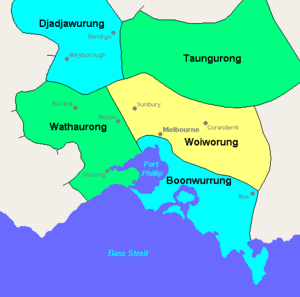Kulin languages facts for kids
Quick facts for kids Kulin |
|
|---|---|
| Ethnicity: | Kulin |
| Geographic distribution: |
Victoria |
| Linguistic classification: | Pama–Nyungan
|
| Subdivisions: |
—
|
 The five Kulin nations
|
|
The Kulin languages are a group of languages. They are spoken by the Kulin people in Victoria, Australia. These languages are part of a bigger language family called Pama–Nyungan. The Kulin languages belong to a specific branch of this family, known as Kulinic.
Main Kulin Languages
The Kulin people speak several closely related languages. Each language is connected to a specific area and group of clans. Here are some of the main Kulin languages:
- Woiwurrung (pronounced Woy-wur-rung): This language was spoken in a wide area. It stretched from Mount Baw Baw in the east to Mount Macedon in the west. The Wurrundjeri-willam were a clan who lived along the Yarra River. Today, Wurundjeri is a common name for people from all Woiwurrung clans.
- Bunurong (pronounced Bun-wurrung): Six clans spoke this language. They lived along the coast from the Werribee River to Wilsons Promontory. The Yalukit-willam clan lived along the coast near Williamstown. Today, Bunurong is the common name for all people from this language group.
- Taungurung (pronounced Tung-ger-rung): This language was spoken north of the Great Dividing Range. It was used in the Goulburn River Valley. This area includes towns like Mansfield and Benalla. Taungurung is now the common name for all people from this language group.
- Wathaurong (pronounced Wadha-wurrung): Fifteen clans spoke this language. Their land was south of the Werribee River and included the Bellarine Peninsula. An escaped convict named William Buckley lived with these people for 32 years.
- Dja Dja Wurrung (pronounced Jar-Jar-wur-rung): Sixteen clans of the Dja Dja Wurrung people spoke this language. Their land was around Bendigo and the central highlands. It stretched east to Kyneton and west to the Pyrenees.
Other Kulinic Languages
Some other languages are also part of the Kulin or Kulinic group:
- Western Central Murray languages: Madhi-Madhi, Ledji-Ledji, and Wadi-Wadi are very similar. They share about 80% of their words. This suggests they might have been a single group.
- Eastern Central Murray languages: This group includes Wemba-Wemba, Baraba-Baraba, and Nari-Nari.
- Tjapwurrung (pronounced Jab-wurrung): Some experts consider this a separate language.
- Bindjali: This language was spoken by the Bodaruwitj people. They lived in south-eastern South Australia. Experts classify Bindjali as a Kulinic language.
How Kulin Languages are Grouped
Experts who study languages often group them into families. This helps us understand how they are related. One expert, Dixon (2002), believes the Kulin languages form three main groups:
- Wuy-wurrung (Woy-wur-rung): This group includes the Wuy-wurrung, Bun-wurrung, and Dhagung-wurrung dialects. A dialect is a different way of speaking the same language.
- Wadha-wurrung (Wadha-wurrung): This is considered a distinct language group.
- Wemba-Wemba (Wemba-Wemba): This is a larger group. It includes many dialects like Jaja-wurrung, Madhi-Madhi, Ladji-Ladji, Wadi-Wadi, Nari-Nari, Baraba-Baraba, Wergaya, and Jab-wurrung.
See also
 In Spanish: Lenguas kulin para niños
In Spanish: Lenguas kulin para niños

All content from Kiddle encyclopedia articles (including the article images and facts) can be freely used under Attribution-ShareAlike license, unless stated otherwise. Cite this article:
Kulin languages Facts for Kids. Kiddle Encyclopedia.
